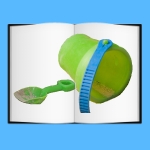
 |
Beach Visit |
We all like going to the beach, and for children it can be a great adventure. They can have fun playing in the sand and water, experience beach creatures up close and learn about the seaside environment. In this delightful book for preschoolers, each turn of the page shows a different thing they may see at the beach.
Children do not need to be able to read, as the story is read to them. They can have fun clicking on the speaker icons to have the story reread.
Pages can be turned forwards and backwards by clicking on the turned corner at the bottom of the pages. Children can also use click and drag in the direction of the arrow. This makes the reader feel like they are turning the page of a real book.
To exit, click on the small hand in the upper right corner of the screen.
Outcome 2: Children are connected with and contribute to their world
Outcome 4: Children are involved and confident learners
Outcome 5: Children are effective communicators
Knowledge of beach environment and experiences
Understand that print carries meaning
Enrich vocabulary
Relate images to text
Listening
Observation
Completing a picture
Programme navigation
Mouse control - single click
Mouse control - click and drag
This book has the narrative of what the reader saw at the beach. It also has a simple puzzle to complete, by replacing part of each beach picture. This involves click and drag mouse control and is great practise in this skill for younger children. If they drop the object before placing it, it will bounce back to its original position. Encourage them to keep trying and with practise they will master this skill.
Children's safety is of the highest priority when going to the beach. Children need to understand that they need to be supervised at all times in and near the water.
Children need to be protected from the sun. Here are some points to consider.
Individually these tips will help, but when used in conjunction with each other, they will give us the best chance of preventing irreversible damage from harmful UV radiation.